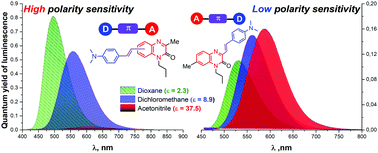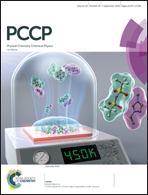Novel quinoxalinone-based push–pull chromophores with highly sensitive emission and absorption properties towards small structural modifications†
Abstract
The photophysical properties of a series of novel push–pull quinoxalinone-based chromophores that strongly absorb and emit light in the broad visible spectrum were comprehensively studied both experimentally and through quantum chemical methods. The drastic influence of the position of the electron-donor dimethylaminostyryl (DMAS) in the quinoxalinone core on its absorption and emission intensities as well as on the solvatochromic behavior of the concerned isomers has been established. No dependence of the photophysical properties of the chromophores on the conformation of the DMAS group was found. Quantum chemical computations provided a reliable theoretical rationalization of the observed spectral features, in particular, the important one related to Stokes shift. The local or intramolecular charge-transfer (ICT) character of the key electronic transitions has been assessed using a quantitative natural transition orbitals analysis and based on the novel topological descriptors of the electronic density rearrangement. This study shows that the ICT effects are not the primary factors contributing to the drastic difference in the emission efficiency of push–pull chromophores that are structurally very similar.



 Please wait while we load your content...
Please wait while we load your content...